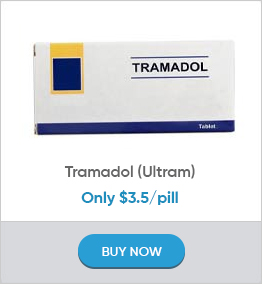Tramadol is a synthetic opioid medication commonly used for the management of moderate to severe pain. It falls under the category of a centrally-acting analgesic, which means that it reduces pain by having an impact on the central nervous system. Tramadol is used to treat a number of ailments, such as neuropathic pain, chronic pain, and postoperative pain. As an alternative to currently available opioid analgesics, tramadol was created with the goal of delivering efficient pain treatment with a lower risk of dependence and respiratory depression than conventional opioids. Tramadol has gained widespread availability in the world’s pharmaceutical industry since its launch. Both generic and branded versions of Tramadol are offered, and they are both sold under numerous brand names. With numerous pharmaceutical companies producing and selling the drug, it has a considerable market presence.
Usually offered in a variety of forms, tramadol is accessible as immediate-release tablets, extended-release tablets, and capsules. While the extended-release version delivers a lengthy duration of action, allowing for round-the-clock pain management, the immediate-release form offers fast pain relief.
Dynamics of Tramadol
Tramadol’s analgesic effects are a result of a variety of mechanisms that operate together in its working dynamics.
First off, mu-opioid receptors in the brain and spinal cord are where tramadol interacts most strongly. Tramadol reduces the impression of pain by attaching to these receptors and preventing the transmission of pain signals. Tramadol has a similar effect to other opioids like morphine, however, it has a considerably reduced affinity for mu-opioid receptors. Tramadol shows characteristics that distinguish it from conventional opioids in addition to its ability to bind to opioid receptors. It also functions as an SNRI, an inhibitor of serotonin and norepinephrine reuptake. This means that it inhibits the reuptake of these neurotransmitters in the brain, leading to increased levels of serotonin and norepinephrine in the synaptic cleft. The enhanced availability of these neurotransmitters contributes to the pain-relieving effects of tramadol, and may also have an impact on mood and emotions.
The drug is metabolized in the liver primarily through the cytochrome P450 enzyme system, specifically the CYP2D6 pathway. During metabolism, tramadol undergoes O-demethylation to form its active metabolite, O-desmethyl tramadol (M1). M1 has a higher affinity for mu-opioid receptors than tramadol itself, further contributing to the overall analgesic effect of the drug. The metabolism of tramadol can vary among individuals. Genetic differences in the activity of the CYP2D6 enzyme can lead to variations in how individuals respond to the drug. Some individuals may be “ultrarapid metabolizers,” resulting in faster metabolism of tramadol, while others may be “poor metabolizers,” resulting in a slower metabolism.
Positive Effects of Tramadol
Broad Spectrum of Action
The drug’s dual mechanism of action, combining opioid receptor binding and serotonin-norepinephrine reuptake inhibition, provides a broader spectrum of pain relief compared to traditional opioids alone. This can be particularly beneficial for individuals with pain that is not fully responsive to other medications or those with a component of neuropathic pain.
Extended Duration of Action
Both immediate-release and extended-release versions of this medicine are offered. Extended-release medication has a longer duration of action, enabling sustained pain relief and requiring fewer doses over time. For those who need ongoing pain care without the bother of repeated medication administration, this may be useful.
Potential Mood Enhancement
Tramadol’s ability to decrease the reuptake of serotonin and norepinephrine may have benefits over just pain relief. Some people claim to feel happier, perhaps with less anxiety or a slight antidepressant effect. Tramadol shouldn’t be used as the primary treatment for mood disorders because these effects can differ from person to person.
Analgesic Tendency of Tramadol
Tramadol possesses robust analgesic properties, making it highly effective in relieving pain. Its multifaceted mechanisms of action enable it to address a broad spectrum of pain conditions and intensities. By modulating the opioid system, tramadol effectively reduces pain sensations, bringing comfort to individuals suffering from moderate to severe pain. By impeding the reuptake of these neurotransmitters, tramadol increases their availability in the synaptic cleft. This dual mechanism of action allows tramadol to impact both the opioid pathways involved in pain modulation and the serotonergic and noradrenergic systems responsible for regulating mood and emotions. The combined effects contribute to its powerful pain-relieving capabilities. Tramadol’s efficacy extends to various types of pain, encompassing nociceptive pain resulting from tissue damage and neuropathic pain caused by nerve injury or dysfunction. Its multimodal action allows it to address the sensory and emotional aspects of pain, making it particularly valuable in complex pain scenarios or those involving neuropathic components.
Dosage and Administration Guidelines
Tramadol dosing is often personalized based on factors such as age, body weight, renal function, and other medical conditions. This ensures optimal pain management and minimizes the risk of side effects. For immediate-release Tramadol tablets, the usual starting dose for adults is 50-100 mg taken orally every 4-6 hours as needed for pain relief. The maximum daily dose is generally 400 mg. Extended-release Tramadol formulations are designed to provide long-lasting pain relief. They should not be chewed or mashed; they should be swallowed whole. The typical starting dose for adults is 100 mg taken once daily, with the dose titrated as necessary. The maximum daily dose for extended-release Tramadol is typically 300 mg.
Tramadol should be taken exactly as prescribed, following the specific instructions provided. It can be taken with or without food, but consistent administration with regard to meals is advisable. It is necessary to swallow extended-release tablets or capsules whole, without breaking, crushing, or chewing them.

